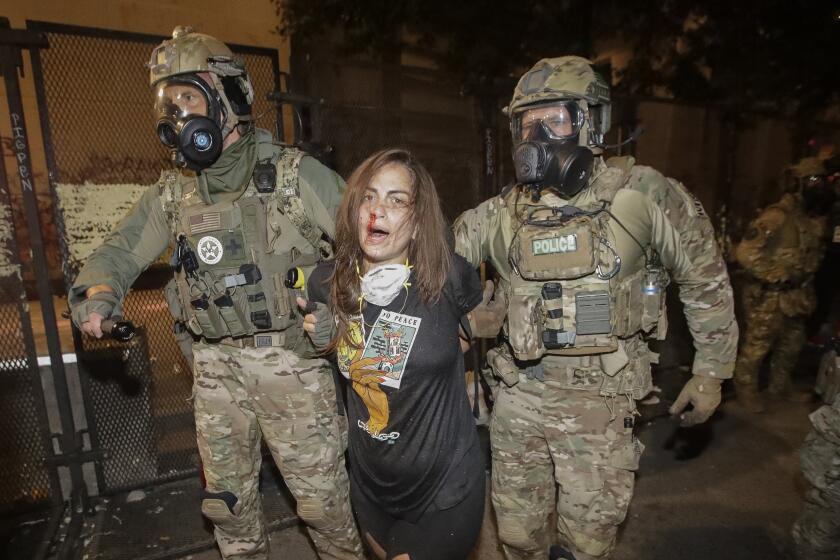The Border Patrol’s brute power in Portland is the norm at the border

- Share via
The recent images out of Portland — camouflaged federal agents pulling people into unmarked vans, firing off tear gas and flash grenades, and beating protesters with batons — have shocked the nation. Many people would like to believe that such violence by agents of the state are what one might witness in Pinochet’s Chile, but the truth is that the scenes from Portland are all too American.
Many of the agents in Portland are members of Border Patrol Tactical Unit (BORTAC), a part of U.S. Customs and Border Protection. Since 9/11, CBP has ballooned to more than 60,000 personnel, making it the largest law enforcement agency in the federal government. In recent years, BORTAC units have even been sent to Iraq and Afghanistan as part of Operation Iraqi Freedom and Operation Enduring Freedom.
What’s happening in Oregon reflects the long history of unprecedented police powers granted to federal border agents over what has become a far more expansive border zone than most Americans realize. The Trump administration’s deployment of BORTAC units to suppress protesters in Portland should compel Congress to rein in the power of these militarized forces, which we have tolerated for far too long.
The original Border Patrol, the precursor of the CBP, was established in the 1920s. For many of its early years, it operated as a law unto itself, known for racial profiling and brutality. From the beginning, its agents fell prey to mission creep. Rather than confining themselves to the national boundaries in policing immigration and smuggling, they often pushed their patrols to strategic points many miles into the interior.
After World War II, Congress codified the broad powers that the agency had assumed for itself. It passed a law in 1946 giving Border Patrol agents authority to arrest undocumented immigrants and to search vehicles “within a reasonable distance from any external boundary of the United States,” without the warrants that would usually be required by the 4th Amendment to protect against unreasonable search and seizure.
In 1953, the Justice Department unilaterally decided that this “reasonable distance” extended 100 miles into the interior from the international land borders with Mexico and Canada, as well as from the U.S.’ maritime borders. The repercussions of this decision have turned out to be profound.
Today, nearly two-thirds of Americans — some 200 million — live in the 100-mile-wide zone overseen by CBP, which encompasses nine of the nation’s 10 largest cities as well as several entire states, among them Hawaii, Florida, New Hampshire, Michigan, Connecticut and New Jersey.
The actions of federal law enforcement officers at protests in Oregon’s largest city are raising the prospect of a constitutional crisis.
President Trump’s recent actions risk collapsing this already questionable distinction between the interior and the exterior for border policing purposes. During the protests in Minneapolis-St. Paul after the killing of George Floyd in late May, the CBP used a Predator drone to monitor the protests, even though its legal authority for doing so remains unclear. The Twin Cities are more than 250 miles from the closest international border.
In early June, CBP dispatched more than 350 agents to Washington, D.C., to suppress the protests there. CBP’s acting Commissioner Mark Morgan defended the deployment in an inflammatory tweet that described the demonstrations as “acts of domestic terrorism.” For the past several days, CBP agents, including BORTAC units, have swarmed into Portland, against the wishes of the city’s mayor and of Oregon’s governor. The seeming justification for this deployment is an executive order Trump recently signed calling for the protection of federal memorials, statues and property. The Oregon attorney general has responded by filing a suit against the Trump administration for violating the protesters’ civil rights.
Border Patrol agents view themselves as a military unit, one with greater discretion in searches, arrests and the use of force than other law enforcement agencies. Their violent treatment of peaceful protesters in Portland has outraged observers. But the fact is, the Border Patrol has been allowed to wield power in a similar manner along the border for decades, with often deadly consequences for Latinos.
On Monday, Trump said that he intended to expand the use of federal border agents across the country, dispatching them to cities run by Democratic mayors, such as New York and Chicago.
The administration’s use of the Border Patrol in Portland shows how readily it can be deployed as a militarized national police force operating outside the normal systems of oversight and accountability. We are long overdue for limiting the CBP’s extraordinary police powers and its 100-mile border zone. Otherwise, Portland will be just the first example of our repressive border regime spreading to the rest of the United States.
Karl Jacoby is a professor of American history and the co-director of the Center for the Study of Ethnicity and Race at Columbia University. He is the author of “The Strange Career of William Ellis: The Texas Slave Who Became a Mexican Millionaire,” among other books.
More to Read
A cure for the common opinion
Get thought-provoking perspectives with our weekly newsletter.
You may occasionally receive promotional content from the Los Angeles Times.










